The Japanese use lots of unique vegetables that may seem unfamiliar. Learn more about these different vegetables, how to cook them, and substitutions if you can’t find them.

You may have encountered unfamiliar produce names when cooking Japanese dishes at home. While easily accessible in Japan, some may be difficult to procure abroad. What are they, how can you eat them, and what are suitable substitutions?
Now that we’ve covered Japanese herbs and spices in part one, let’s look at some popular Japanese vegetables used in Japanese cuisine. Perhaps after reading this, you may be able to expand your Japanese vegetable dish repertoire!

Mizuna (水菜)
Other names: Japanese mustard greens, potherb mustard

Mizuna (“water green”) is a leafy green in the mustard family. It grows in bunches and is available year-round. The green fringed, feathery pointed leaves taste peppery and slightly bitter. The thin white stems are crunchy. There are other varieties, including purple stemmed aka mizuna (赤水菜) or beni houshi (紅法師), round leaf mibuna (壬生菜), and red mizuna aka karashi mizuna (赤からし水菜).
Mizuna was initially an heirloom vegetable from Kyoto, but it is now grown across the country. Add raw or blanched mizuna in salads, stir-fries, hot pots, soups, and pasta dishes.
Suggested substitution: Greens with a spicy kick like watercress, baby spinach leaves, mustard greens, or black kale
Recipes Using Mizuna
Read more about mizuna here.
Komatsuna (小松菜)
Other names: tendergreen, Japanese mustard spinach

Another leafy green in the mustard family, komatsuna has long stems and rounded leaves. The young green leaves are sweet, mild, and tender. It takes a more fibrous texture with a more peppery mustard bite when matured. The stems are pretty crunchy. The name komatsuna refers to Komatsu village (modern-day Edogawa in Tokyo), where it was grown.
Komatsuna is nutrient-dense in calcium, and Vitamin A, B2, C, and K. It is a versatile green vegetable. Use komatsuna in stir-fries, blanched, pickled, braises, or add to soups and hot pot dishes.
Suggested substitution: Mizuna, spinach, mustard greens, bok choy, napa cabbage
Recipes Using Komatsuna
Read more about komatsuna here.
Shungiku (春菊)
Other names: chrysanthemum leaves, edible chrysanthemum, Crown daisy, Chop Suey greens, Kikuna
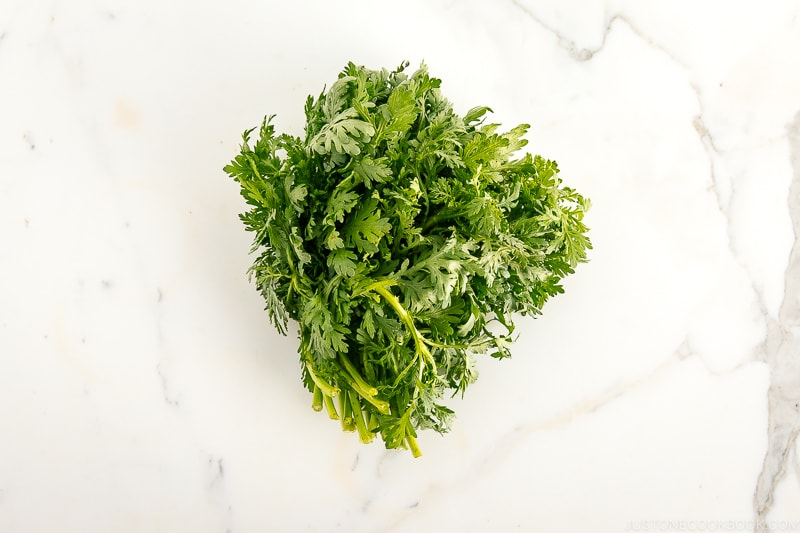
Eaten across East Asia, Shungiku (“spring chrysanthemum”) are aromatic greens. The green leaves can be broad-leaf or narrow-leaf with serrated edges with a fibrous stem. It has a grassy and mildly sweet flavor.
They are an excellent source of potassium, fiber, vitamins A and C, calcium, and flavonoids. Eat shungiku raw or blanched in salads, or add to stir-fries and soups. It’s a must-have in hot pot and sukiyaki.
Suggested substitution: aromatic greens like arugula, watercress, spinach
Recipes Using Shungiku
Read more about shungiku here.
Hakusai (白菜)
Other names: Chinese cabbage, napa cabbage, wombok, Chinese leaf, winter cabbage

Oblong shaped with densely packed leaves, hakusai is a cabbage eaten across East Asia. The crinkly leaves are light green with a white crunchy stem. The cruciferous vegetable is mildly sweet and eaten both raw and cooked. It’s native to China and was introduced to Japan in the late 19th century. The term “napa cabbage” actually originates from Japanese, where “nappa” (菜っ葉) is a colloquial term for leafy greens.
Rich in calcium, vitamins C and K, and antioxidants, you can swap hakusai for cabbage in your cooking. For example, add hakusai in gyoza filling, salads, stir-fries, and pasta dishes. Hakusai is a must-have in hot pot.
Suggested substitutions: cabbage, bok choy
Recipes Using Hakusai
Read more about hakusai here.
Negi (ネギ)
Other names: Naga Negi (long onion 長ネギ), Shiro Negi (white onion 白ネギ), or Tokyo Negi (東京ネギ), Welsh onion, green onion

Negi is an allium with a thick and long white stem and hollow green tops. While it’s spicy and sharp when raw, it develops a sweet flavor when cooked. When thinly sliced, it’s often used as a garnish for noodles and rice bowls. Negi can withstand prolonged cooking and thus is a popular addition to hot pots, miso soup, and nimono. You may also see it skewered and grilled in yakitori.
Suggested substitution: scallions, leeks, garlic chives/Chinese chives, spring onions
Recipes Using Negi
Read more about negi here.
Edamame (枝豆)
Other names: maodou

Edamame (“branch beans”) are immature soybeans. It belongs to the legume family, and the beans are bright green and encased in pods with two or three beans each. Edamame is a summer vegetable, although it is also available frozen year-round. Once blanched or boiled in their pods, the beans are sweet, nutty, and slightly grassy.
Edamame is a popular snack at an izakaya (Japanese gastropubs), where diners would pop the beans from the shells at the table. It can also be mixed into steamed rice or fried rice, mixed with tempura batter, or pureed for soups. It also adds color to a dish, so you could scatter shelled edamame on rice bowls or stir-fries.
Suggested substitution: mukimame (shelled edamame), sugar snap peas, garbanzo beans
Recipes Using Edamame
Read more about edamame here and learn how to cook it here.
Azuki (小豆)
Other names: Adzuki, red beans, red mung beans, red cowpeas

Azuki (“little beans”) are legumes with a dark reddish color, about 5mm or 1/4in length. The beans are eaten throughout East Asia and the Himalayas. When cooked, it partakes in a nutty and sweet flavor. It’s high in dietary fiber, potassium, folate, magnesium, manganese, B-vitamins, and other nutrients. The Japanese use azuki in both sweet and savory dishes.
Sweet azuki bean paste called anko (あんこ) is an indispensable ingredient in wagashi (和菓子, traditional Japanese confectionery). It can also be used in western desserts. Depending on your preference, the paste may be chunky or sweet and has a dark reddish sheen. The celebratory dish sekihan (赤飯), made of glutinous rice and azuki beans, is served at many festivals and events.
Suggested substitution: mung beans, kidney beans, cannellini beans
Recipes Using Azuki
Read more about azuki here.
Kuromame (黒豆)
Other names: black soybeans, kuro daizu (黒大豆)

Kuromame (“black beans”) are jet black soybeans. When cooked, it has a buttery smooth texture and is nuttier and sweeter than yellow soybeans. It’s high in dietary fiber, amino acids, minerals, and protein.
In Japanese cuisine, kuromame cooked in sweet syrup is one of the essential dishes in the Japanese New Years’ feast. It’s sweet and a tiny bit savory due to the addition of soy sauce. You will also see kuromame in various desserts, such as cakes and wagashi. If you’re looking for a caffeine-free tea, try kuromame-cha (黒豆茶), a reddish-brown tea packed with antioxidants.
Suggested substitution: red kidney beans, black beans
Recipes Using Kuromame
Read more about kuromame here.
Kabocha (南瓜)
Other names: Japanese pumpkin, kabocha squash
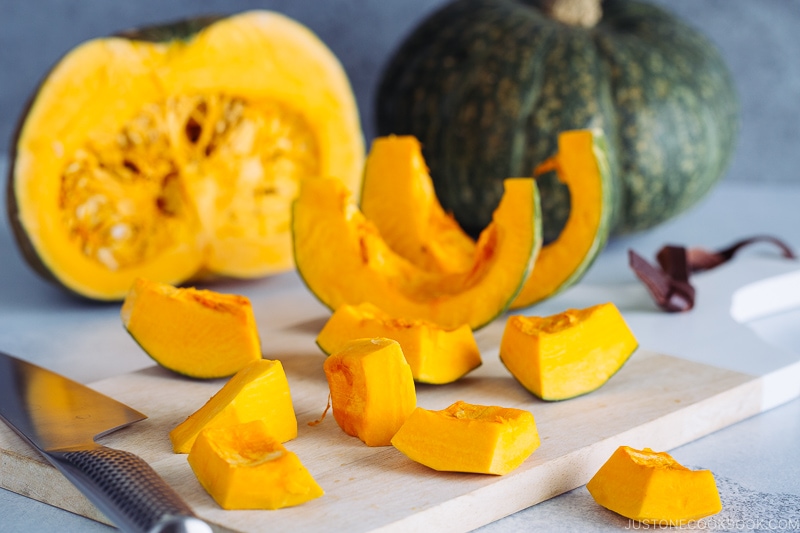
A winter squash, kabocha (“western melon”) is round and squat, with a spotted forest green exterior and bright orange flesh. It takes a buttery, rich, nutty flavor reminiscent of sweet potato and chestnut when cooked. Because of these attributes, it’s used in both savory and sweet applications. The squash is rich in vitamins A, C, B, calcium, iron, and fiber.
During the winter solstice, the Japanese eat kabocha simmered dashi or as a sweet soup. You will see many kabocha desserts during the fall to winter seasons, a sign of cold spells.
Suggested substitution: butternut squash, acorn squash, satsumaimo
Recipes Using Kabocha
Read more about kabocha here and learn how to cut it.
Satsumaimo (さつま芋)
Other names: Japanese sweet potato, Japanese yam

These long, slender tubers have distinctive red or purple skin and pale yellow insides. A symbol of autumn in Japan, it’s enjoyed in savory and sweet dishes. While there’s a vast range of regional varieties, it tends to be creamy, starchy, and sweet once cooked. It’s also a key ingredient in shochu (焼酎), Japanese distilled alcohol. The name hails from the Satsuma region (present-day Kagoshima prefecture), where it was cultivated.
During the cold months in Japan, you may see stalls and carts selling roasted satsumaimo. It’s also used in cozy braises and chunky soups, which will undoubtedly warm you up from inside. It’s one of the ingredients for kuri kinton (栗きんとん), chestnuts in satsumaimo paste that’s eaten at the New Years’ feast. You could also treat satsumaimo like sweet yams in desserts like pies.
Suggested substitution: sweet potatoes
Recipes Using Satsumaimo
Read more about satsumaimo here.
Daikon (大根)
Other names: giant white radish, Japanese radish, Chinese radish, Asian radish, winter radish

The slender long white root vegetable daikon (“big root”) is dense, crispy, and crunchy. Eaten raw, cooked, dried, and pickled, daikon is a versatile vegetable. Daikon is harvested year-round and the season peaks during the colder months. Winter daikon is sweeter than the summer. There are other varieties, such as watermelon radish (koushin daikon 紅芯大根), black mooli daikon (kuronaga daikon 黒長大根), and red daikon (beni daikon 紅大根).
Daikon has a mildly peppery flavor and can be eaten entirely, from the top leaves to the root. The leaves have a grassy green flavor and it’s one of the most cultivated vegetables in Japan. Daikon is an indispensable vegetable in Japanese cooking. It’s high in fiber, potassium, vitamin C, and other minerals. It is a purifying food to detox the body and stimulates digestion.
Grated daikon is a refreshing palate cleanser served with grilled fish, tempura, fried foods, and soba. The spiciness disappears when cooked in soups, braises, and stir-fries and becomes slightly sweet. It has also been eaten dried and pickled to last through the harsh winters. Kiriboshi daikon is dried daikon strips simmered in dashi.
Suggested substitution: turnips, other root vegetables
Recipes Using Daikon
Read more about daikon here.
Renkon (蓮根)
Other names: lotus root, Sacred Water lotus, Chinese Arrowroot
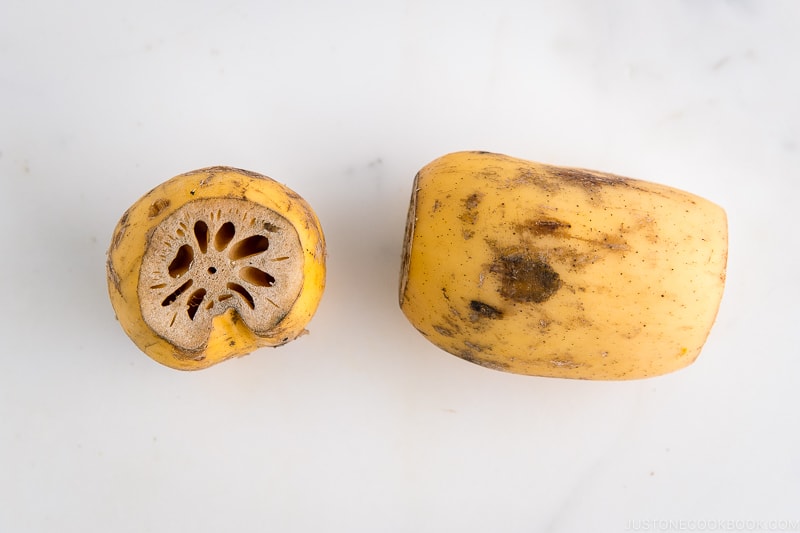
An oblong, tubular rhizome that grows underground in water, renkon (“lotus root”) resembles thick white sausage links. When sliced, it has symmetrical air pockets patterned into a pinwheel shape. Renkon is always cooked first and cannot be consumed raw. It has a dense and crunchy texture similar to water chestnut or taro. It’s a popular ingredient in Asian cuisine due to its aesthetics.
It’s high in dietary fiber, carbohydrates, and vitamin C. It can be steamed, fried, braised, and boiled. You may be able to find pre-blanched renkon whole or sliced for easy cooking.
Suggested substitution: Any similar crunchy root vegetables
Recipes Using Renkon
Read more about renkon here.
Gobo (牛蒡)
Other names: burdock root

Resembling a narrow and slender root, gobo has a thin beige skin with a pale white interior with hairs. Eaten blanched, stir-fried, or boiled, it has a crunchy texture even with prolonged cooking with a mild and earthy taste.
Available year-round, it’s an excellent source of potassium, fiber, amino acids, calcium, and antioxidants. The Japanese stir-fry gobo in soy sauce and sesame seeds for kinpira gobo. You can also add it to nimono and miso soups.
Suggested substitution: Any similar crunchy root vegetables
Recipes Using Gobo
Read more about gobo here.
Kabu (蕪)
Other names: Japanese turnips, Tokyo turnips, salad turnips

Small, bulb-shaped, and with a single tendril tail, kabu is crisp and sweet. The round frilled green leaves are also edible and can be cooked like any other greens. Unlike other turnips, you can eat kabu raw. It’s available during the cold seasons.
Kabu are high in vitamin C. When cooked in braises and soups or roasted, it has a sweet, buttery texture. It’s also used to make tsukemono.
Suggested substitution: Any similar crunchy root vegetables
Recipes Using Kabu
Read more about kabu here.
Takenoko (筍)
Other names: bamboo shoots

Takonoko is the soft top of a young bamboo plant. The harvest season is in spring, before the plant pokes out of the soil. The tough outer layers are removed, and the inner core is boiled. For convenience, you may be able to find it frozen or parboiled, although fresh takenoko is sublime.
The taste is mild, sweet, and firm, like baby corn. Fresh takenoko dishes are a sure sign of spring, and the Japanese consume them grilled, mixed with rice, tempura, stir-fries, or soups.
Suggested substitution: Any similar crunchy vegetables such as water chestnut, Jerusalem artichokes/sunchokes, baby corn
Recipes Using Takenoko
Read more about takenoko here.
Shishi Togarashi/Shishito (獅子唐辛子・獅子唐)
Other names: Japanese peppers
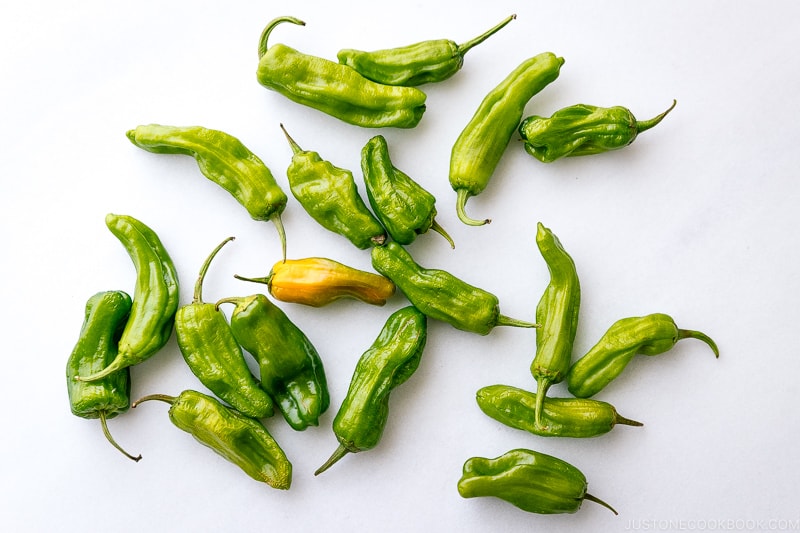
These lime green finger-sized wrinkly peppers have a grassy and slightly bitter flavor like green bell peppers. Approximately one in ten are fiercely spicy, so watch out! These peppers are young pods harvested early and turn bright red when mature. The name shishi (獅子) refers to the Chinese guardian lion, as the tip of the shishito supposedly resembles it.
It has a thin and glossy skin with wrinkles on the surface. It is harvested year-round and reaches peak season in the spring to summer seasons. It’s an excellent source of fiber, vitamins A, B6, C, and K, folate, and potassium. It’s often eaten whole, grilled, deep-fried, sauteed, or simmered.
Suggested substitution: green bell peppers, Padrón peppers
Recipes Using Shishito
Read more about shishito here.
Satoimo (里芋)
Other names: Japanese sweet taro, taro root

Satoimo is a mild-flavored starchy root crop widely enjoyed in Japanese cuisine. Compared to other varieties of taro, satoimo is smaller in size with a round body, hairy brown skin, and tapered ends. It has a firm and creamy white flesh and a somewhat slimy texture that can irritate the skin.
It’s high in fiber and potassium and low in calories than potatoes, making it a healthier alternative without compromising the starchy texture. The Japanese use satoimo in nimono or add chunks in miso soup.
Suggested substitution: satsumaimo, parsnips
Recipe Using Satoimo
Read more about satoimo here.
Kyuri (きゅうり)
Other names: Japanese cucumber
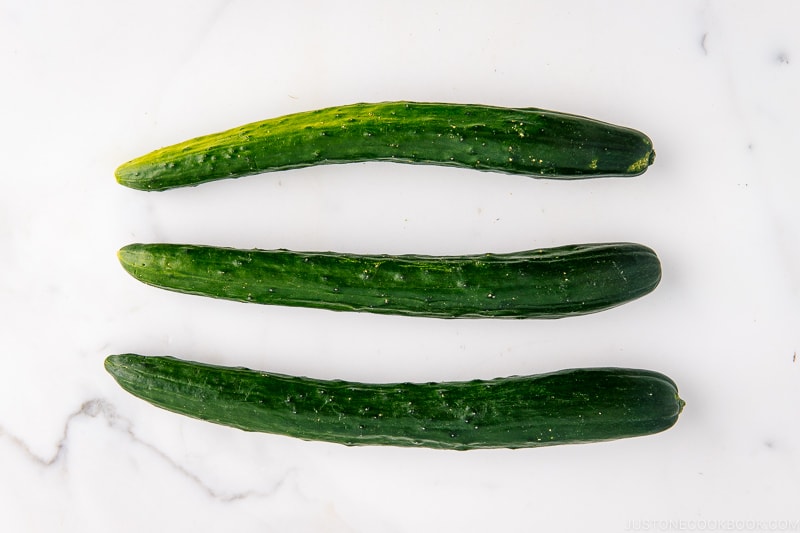
Kyuri is a variety of cucumber native to Japan and China. Compared to English cucumbers, it’s shorter, thinner, and narrow, with lots of ridges. The thin skin is a deep forest green with a fleshy and crunchy texture. The tiny immature seeds are tasteless. Kyuri is refreshing with a mild melon-like flavor.
It’s used in various cooked, pickled, and raw dishes. It is especially popular during the hot season for its cooling properties. It’s a great source of vitamins A, C, K, and E, and minerals such as potassium, magnesium, and manganese.
Suggested Substitution: Persian cucumber
Recipes Using Kyuri
Read more about kyuri here.
Nasu (なす)
Other names: nasubi, Japanese eggplant

With an elongated and slender body, nasu come in a range of purple shades, from a royal purple color to almost black. Underneath the glossy and thin skin is a spongy cream-colored flesh. It develops a soft and creamy texture that becomes an excellent vehicle for absorbing assertive sauces and flavors when cooked. It has a sweet and mild flavor. While available year-round, it peaks in the summer months.
Like many summer vegetables, nasu is known for its cooling properties. It’s high in vitamins C and K and contains nasunin, an antioxidant that protects cells against free radicals. The Japanese use nasu in various cooked and raw dishes such as tsukemono. As nasu cooks quickly, it’s excellent in braises, stir-fries, deep-frying, and grilling.
Suggested substitution: Chinese eggplant, long eggplant, Italian eggplant
Recipes Using Nasu
Read more about nasu here.
Wish to learn more about Japanese cooking? Sign up for our free newsletter to receive cooking tips & recipe updates! And stay in touch with me on Facebook, Pinterest, YouTube, and Instagram.






More Stories
Sage Recipes: 3 Tasty Dishes To Try For Dinner
The Restaurant City Secrets Series – Top Ways to Earn Gourmet Points in Restaurant City
What Makes Caribbean Food Special?